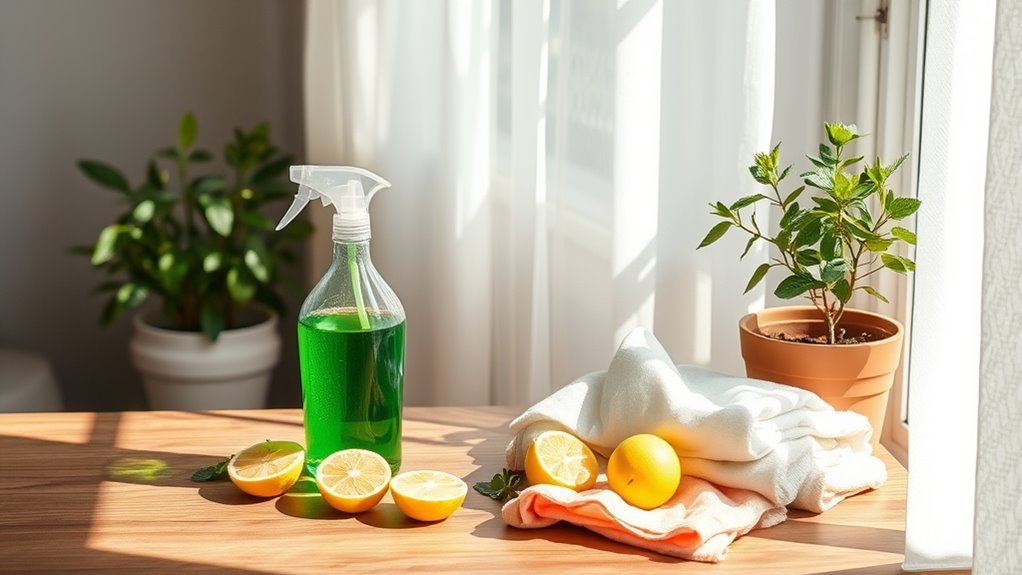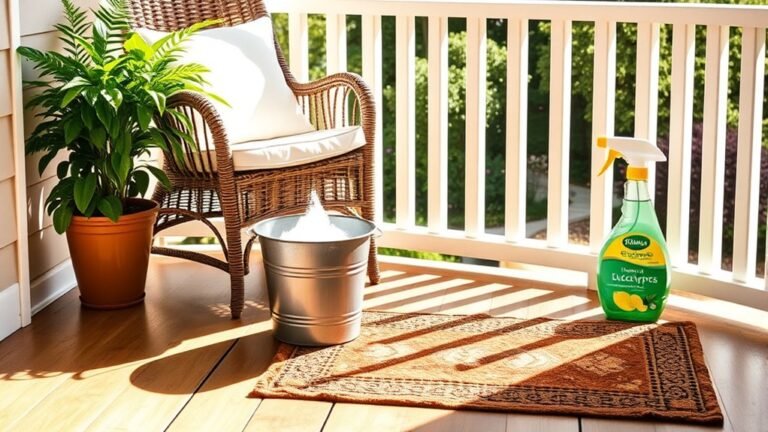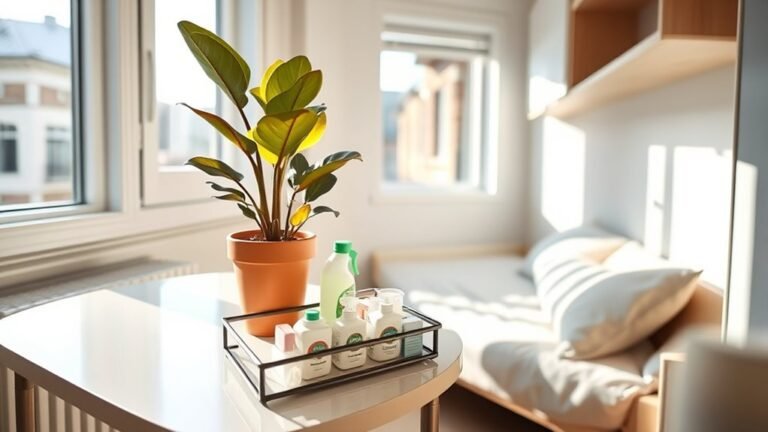DIY Cleaner for Bedroom
You can make an easy, natural DIY cleaner for your bedroom using simple ingredients like white vinegar, baking soda, and essential oils. Mix equal parts distilled water and vinegar in a spray bottle, then add your favorite essential oils for a fresh scent. This all-purpose spray works great on surfaces, while sprinkling baking soda on carpets removes odors. For fabric, a gentle vinegar and water mix refreshes curtains and upholstery. Keep exploring to find more recipes and eco-friendly cleaning tips.
Essential Ingredients for Homemade Bedroom Cleaners

Although you can find many commercial cleaners, making your own bedroom cleaner lets you control the ingredients and avoid harsh chemicals. Choosing natural ingredients like white vinegar, baking soda, and essential oils gives you the freedom to tailor your cleaner to your preferences. These components offer powerful cleaning benefits without the toxins found in many store-bought products. White vinegar naturally cuts through grime, baking soda deodorizes and gently scrubs surfaces, and essential oils add a fresh scent while providing antibacterial properties. By using these simple, natural ingredients, you take charge of what touches your personal space, ensuring a healthier environment for you. Embracing this DIY approach not only cleans your bedroom effectively but also aligns with your desire for freedom and control over your surroundings.
How to Make a Natural All-Purpose Spray
Creating a natural all-purpose spray requires just a few simple ingredients and minimal effort. You’ll enjoy eco friendly alternatives that clean effectively without harsh chemicals. Grab a spray bottle, distilled water, white vinegar, and a few drops of your favorite essential oils for natural fragrances. Mix them to create a versatile spray perfect for your bedroom surfaces.
| Ingredient | Quantity | Purpose |
|---|---|---|
| Distilled Water | 1 cup | Dilutes solution |
| White Vinegar | 1 cup | Disinfects & cleans |
| Essential Oils | 10-15 drops | Adds natural scent |
Shake well before each use. This spray frees you from synthetic cleaners, giving your space a fresh, safe vibe.
DIY Fabric Refresher for Curtains and Upholstery

You can freshen up your curtains and upholstery with a simple DIY fabric refresher using just a few essential ingredients. I’ll walk you through a quick step-by-step mixing guide to make it easy. Plus, I’ll share some handy application tips to get the best results every time.
Essential Ingredients Needed
Five simple ingredients make up an effective DIY fabric refresher for your curtains and upholstery. You’ll want to gather natural ingredients that not only clean but also bring fresh scents and freshness to your fabrics. Start with distilled water as a pure base, then add white vinegar for its powerful cleaning benefits and odor-neutralizing properties. Baking soda is essential, helping to lift dirt and absorb smells naturally. A few drops of essential oils—like lavender or eucalyptus—offer a pleasant fragrance and added antibacterial effects. Finally, a small amount of rubbing alcohol speeds drying and boosts the cleaner’s effectiveness. These straightforward natural ingredients give you freedom from harsh chemicals while delivering a fresh, clean fabric that breathes new life into your bedroom.
Step-by-Step Mixing Guide
Before mixing your DIY fabric refresher, make certain you have all the ingredients and tools ready, such as a spray bottle and a measuring cup. Start by measuring 1 cup of distilled water, then add 1 tablespoon of white vinegar and 10 drops of your favorite essential oil for a fresh scent. These mixing ratios guarantee your fabric refresher is effective without damaging delicate curtains or upholstery. Always mix in a clean container to avoid contamination. Remember, safety precautions are key: avoid using this spray near open flames, and test a small fabric area first to prevent discoloration. Once mixed, pour your solution into the spray bottle, label it clearly, and shake gently before each use. This simple guide lets you refresh your fabrics freely and safely.
Application Tips and Tricks
Although the DIY fabric refresher is simple to make, applying it correctly guarantees the best results. To keep your curtains and upholstery fresh and inviting, follow these tips:
- Test a small hidden area first to verify your chosen scent combinations don’t cause discoloration.
- Spray lightly and evenly from about 12 inches away to avoid saturating the fabric, which can lead to damp spots.
- Incorporate the refresher into your regular cleaning schedules, applying it every 1-2 weeks to maintain a fresh atmosphere without overwhelming scents.
Homemade Dusting Spray for Furniture

You can easily make a homemade dusting spray using simple ingredients like water, a bit of vinegar, and a few drops of essential oil. Just mix them in a spray bottle, and you’re ready to freshen up your furniture quickly. To get the best results, lightly mist your cloth instead of spraying directly on surfaces to avoid streaks or damage.
Ingredients for Dusting Spray
Creating a homemade dusting spray is easier than you might think, and it only requires a few simple ingredients. By choosing natural alternatives, you can skip harsh chemicals and enjoy a fresh, safe way to clean your furniture. Here are three essential homemade ingredients to get you started:
- Water – Acts as the base, diluting other ingredients for a gentle clean.
- White vinegar – A powerful natural cleaner that helps cut through dust and grime without damaging surfaces.
- Essential oils – Add a pleasant scent and extra antibacterial properties; lemon or lavender work great.
These ingredients not only keep your bedroom fresh but also give you the freedom to control what touches your living space. Making your own dusting spray lets you clean smarter and live healthier.
Application Tips and Tricks
When using your homemade dusting spray, it’s best to apply it sparingly to avoid dampening surfaces too much. Lightly mist your cloth instead of spraying directly on furniture—this helps control moisture and prevents damage. Use gentle, circular motions with a microfiber cloth to lift dust without scratching. Adjust your application techniques depending on the furniture’s material; for delicate wood, less is more. As for cleaning frequency, dusting once a week keeps surfaces fresh and reduces buildup, but feel free to tweak it based on your lifestyle. Staying consistent with these simple steps gives you freedom from harsh chemicals while maintaining a clean, inviting bedroom. Embrace these tips, and your DIY cleaner will work efficiently without overwhelming your space.
Cleaning and Deodorizing Carpets Naturally
A fresh, clean carpet can transform your bedroom’s atmosphere without harsh chemicals. Embracing natural deodorizing methods not only frees you from toxins but also revitalizes your space. Here’s a simple way to achieve effective carpet cleaning:
- Sprinkle baking soda generously over your carpet; it absorbs odors naturally.
- Add a few drops of your favorite essential oil—like lavender or eucalyptus—to the baking soda for a rejuvenating scent.
- Let it sit for 15-30 minutes, then vacuum thoroughly to lift dirt and odors.
This method guarantees your carpet feels fresh and smells inviting, all while keeping your bedroom environment healthy and chemical-free. You’ve got the freedom to maintain a pure, cozy space without compromising on cleanliness or comfort.
Removing Stains From Bedding With Simple Solutions
Keeping your carpet fresh sets a great foundation, but stains on your bedding can quickly disrupt that clean feeling. For effective stain removal, act fast—blot spills with a clean cloth to prevent setting. Mix a simple solution of equal parts water and white vinegar or a gentle detergent to treat spots. Dab the stain gently, avoiding harsh scrubbing that can damage fibers. When it comes to bedding care, always check fabric labels and wash with cold water to preserve colors and texture. Air-dry your linens when possible, as heat can fix stains permanently. By using these straightforward, natural methods, you maintain your freedom from harsh chemicals while keeping your bedding fresh, clean, and inviting night after night.
Tips for Eliminating Odors Without Chemicals
Although odors can linger in your bedroom, you don’t need harsh chemicals to freshen the air. Embracing natural odor absorbers and air purifying plants lets you maintain a clean, inviting space without compromising your freedom from toxins. Here are three effective tips:
Refresh your bedroom naturally with odor absorbers and plants, keeping air clean without harsh chemicals.
- Use Baking Soda – Sprinkle it on carpets or mattresses, let it sit for 15 minutes, then vacuum. It naturally absorbs odors.
- Place Air Purifying Plants – Plants like spider plants or peace lilies filter the air and add a revitalizing vibe.
- Ventilate Daily – Open windows to let fresh air in and push stale smells out.
These simple steps keep your bedroom smelling fresh and chemical-free, empowering you to enjoy a healthier, more liberated environment.
Best Practices for Eco-Friendly Cleaning
When you want to clean effectively without harming the environment, choosing eco-friendly methods is key. Start by selecting eco friendly materials like vinegar, baking soda, and essential oils—they’re safe, affordable, and versatile. Avoid harsh chemicals that harm your health and the planet. Embracing sustainable practices means using reusable cloths instead of disposable wipes and minimizing water waste during cleaning. You can also repurpose containers to reduce plastic use and store your DIY cleaners in glass bottles. Keep your routine simple and intentional: clean only what’s necessary to save resources. By adopting these habits, you not only maintain a fresh, healthy bedroom but also enjoy the freedom of knowing your cleaning choices protect the Earth for the future.
Storing and Using Your DIY Cleaners Safely
After choosing eco-friendly ingredients for your DIY cleaners, it’s important to know how to store and use them safely to maintain their effectiveness and protect your home. Proper safe storage and cleaning safety practices guarantee your freedom to clean confidently without risks.
- Label your containers clearly, including ingredients and date made, so you know exactly what’s inside and when to refresh them.
- Store your DIY cleaners in a cool, dry place away from direct sunlight to preserve their potency and prevent degradation.
- Keep your cleaners out of reach of children and pets to avoid accidental ingestion or contact, guaranteeing everyone’s safety.
Frequently Asked Questions
Can DIY Cleaners Damage Delicate Bedroom Surfaces?
You might worry if homemade cleaners could harm delicate surfaces, but it really depends on surface compatibility. Not all DIY recipes suit every material, so you need to test first. When you get it right, you’ll enjoy great cleaning effectiveness without harsh chemicals. This freedom lets you customize your cleaner to protect your stuff while keeping things sparkling. Just be cautious and always spot-test to keep your surfaces safe.
How Often Should I Clean My Bedroom With Homemade Products?
You should aim for a cleaning frequency that fits your lifestyle—usually once a week works well to keep things fresh. For maintenance tips, spot clean spills immediately and dust surfaces regularly to prevent buildup, making deep cleans easier. If you prefer a more relaxed pace, focus on high-traffic areas and freshen the space with natural scents. That way, you enjoy freedom while keeping your bedroom comfortable and inviting.
Are DIY Cleaners Safe for Pets in the Bedroom?
When it comes to cleaning, you want to make certain it’s a walk in the park for your furry friends. Using pet friendly ingredients like vinegar, baking soda, and gentle essential oils guarantees cleaning safety without harsh chemicals. You don’t have to sacrifice a fresh space for your pet’s health. Just avoid toxic substances like bleach or ammonia, and always test in small areas first. That way, you’re free to keep your home clean and safe together.
Can I Use Essential Oils if Someone Has Allergies?
If someone has allergies, you might want to skip essential oils since they can trigger reactions. Instead, consider essential oil alternatives like distilled white vinegar or baking soda, which are allergy friendly ingredients. These options let you clean freely without worrying about sensitivities. You don’t have to compromise on a fresh, clean space—there are plenty of ways to keep things safe and comfortable for everyone involved.
What Is the Shelf Life of Homemade Bedroom Cleaners?
You’ll find that the shelf life of homemade cleaners usually lasts about one to two weeks, depending on the ingredients you use. To keep them fresh longer, store your mixtures in airtight containers away from direct sunlight and heat. Don’t forget to label them with the date you made them. These storage tips help maintain their effectiveness, so you can enjoy the freedom of creating your own cleaning solutions without worrying about spoilage.






